10 Things to Do at Lake Quinault, Olympic National Park and Forest
In the southwestern corner of Olympic National Park lies one of its most accessible wilderness areas.
The Quinault Valley, which encompasses both Lake Quinault and the Quinault Rain Forest, is easily one of my favorite places in this extraordinary national park. I’ll tell you why below.
Every time I visit Olympic National Park, I’m more impressed by it. Whether it’s the mountains or rain forests or spectacular coastline, I really love the variety of this park. And the Quinault Valley is the perfect example of that.
Featuring various lake activities, such as boating and fishing, as well as fantastic wildlife viewing, great hiking, breathtaking Quinault Rain Forest scenery, and some beautiful Lake Quinault waterfalls, the many things to do at Lake Quinault will keep you busy for a day or two (and possibly more).

This blog post about the best things to do at Lake Quinault contains affiliate links. You can read more about our Terms of Use / Disclosure here.
10 Things to Do at Lake Quinault, Olympic National Park and Forest
Encompassing both Lake Quinault and the Quinault River, the Quinault Valley is one of the Pacific Northwest’s greatest natural gems.
Much less famous and quieter than other attractions in Olympic National Park, such as Ruby Beach, the Hoh Rain Forest and Sol Duc Falls, this is a great destination for a weekend getaway.
Unless you’re planning an overnight trek into the Enchanted Valley or the heart of the Olympic Mountains, two days and a night (or two) are all you need to fully enjoy the beauty of the Quinault Valley.
I, myself, spent two days and one night in the area. So, if you’re trying to figure out what to do at Lake Quinault, I’ve got a bunch of suggestions for you below.
I did all these things in just a couple of days—easily and with time to spare to hang out, drink in hand, near the lake.
Let’s start with the one thing that links all other Lake Quinault activities…
Drive the Quinault Rain Forest Loop Drive
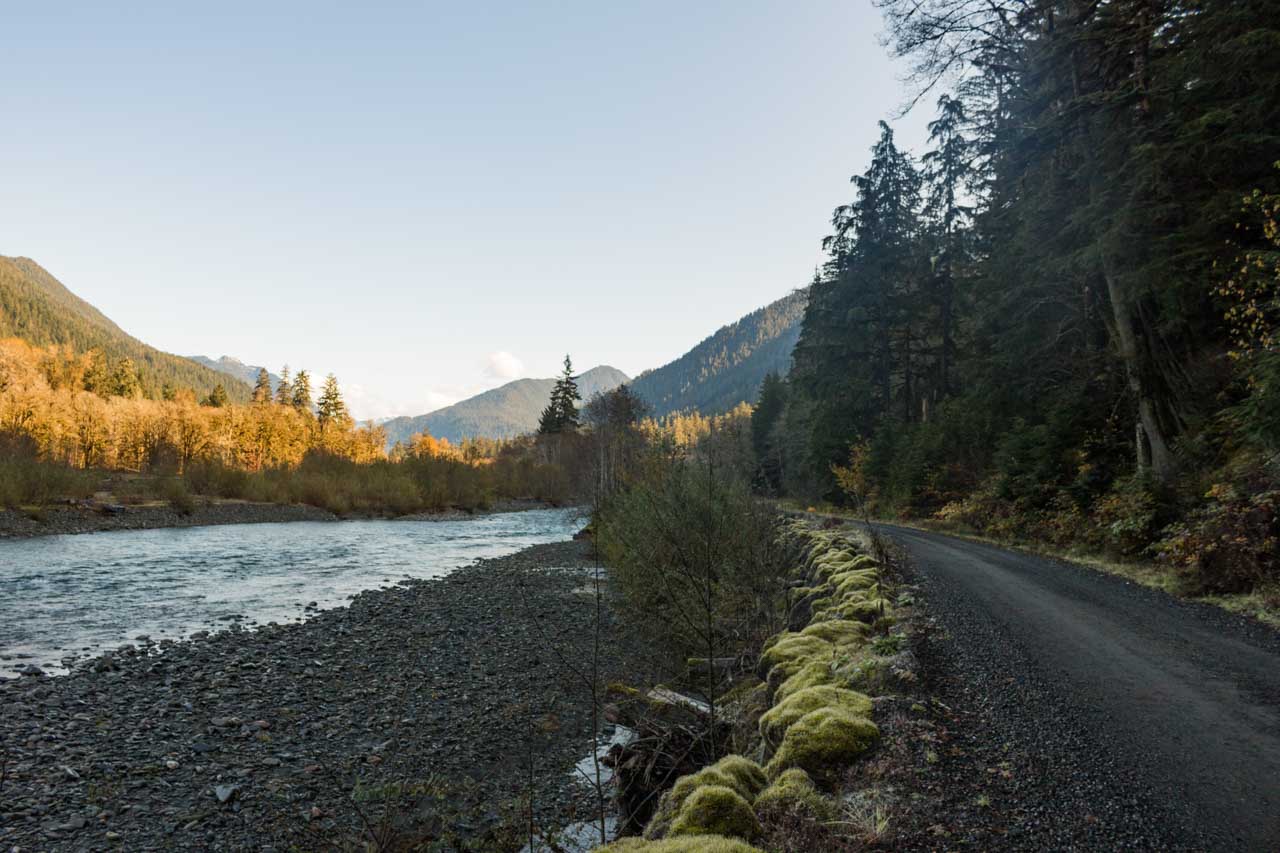
The Quinault Rain Forest Loop Drive is a 31-mile scenic drive that circles around Lake Quinault and a section of the Quinault River, into Olympic National Park and back out on the other side.
This is unquestionably one of the best things to do at Lake Quinault, not only because it links together all other Quinault Rain Forest attractions, but also because it’s simply a fun driving experience.
The sections of the road along the south and north shore, as well as a part along the river, are paved and accessible to RVs and trailers.
However, the wilderness part of this Lake Quinault loop drive is unpaved and not suitable for those larger vehicles. Occasionally, there are sharp turns, loose gravel, narrow stretches and steep inclines.

On this spectacular drive, you’ll travel through both Olympic National Forest (along the southern lake shore and southern riverbank) and Olympic National Park (easternmost part, northern riverbank and lake shore).
You’ll cruise through magical rain forest scenery, past beautiful waterfalls, and alongside a wild river. Sporadic views of the snow-capped Olympic Mountains in the distance will make you feel as if you’re truly in a wilderness. And, you actually are!
While driving the Quinault Rain Forest Loop Drive, you’ll pass numerous Lake Quinault highlights. I’ve listed them in order below, starting at the historic Lake Quinault Lodge and going in a counterclockwise direction.
Note: This is a very wet region and storms can sometimes severely damage Quinault Valley roads.
Check road conditions at the Olympic National Forest Pacific Ranger Station next to the Lake Quinault Lodge, or at the Olympic National Park Quinault River Ranger Station on the north shore.
Hike the Quinault Loop Trail

When you visit Lake Quinault Lodge, whether it’s for a stay or just a peek inside, I highly recommend the Quinault Loop Trail. This is a collection of several shorter Lake Quinault south shore hiking trails that loop through the rain forest across the road from the lodge.
You can combine them as you see fit. The total distances range from about 1.5 to 8 miles.
If I may suggest one specific hike, it’d be the combination of the Lakeshore Trail, the Rain Forest Nature Trail Loop, and the trails through Cedar Bog and past Cascade Falls. This combined Quinault Rain Forest trail is about 4 miles long and takes two hours.
My recommend place to start this amazing Olympic hike is the Lake Quinault Lodge. Alternatively, you can also start at the Rain Forest Nature Trailhead, about a mile up the road from the lodge.
Gaze Up at the World’s Largest Sitka Spruce Tree
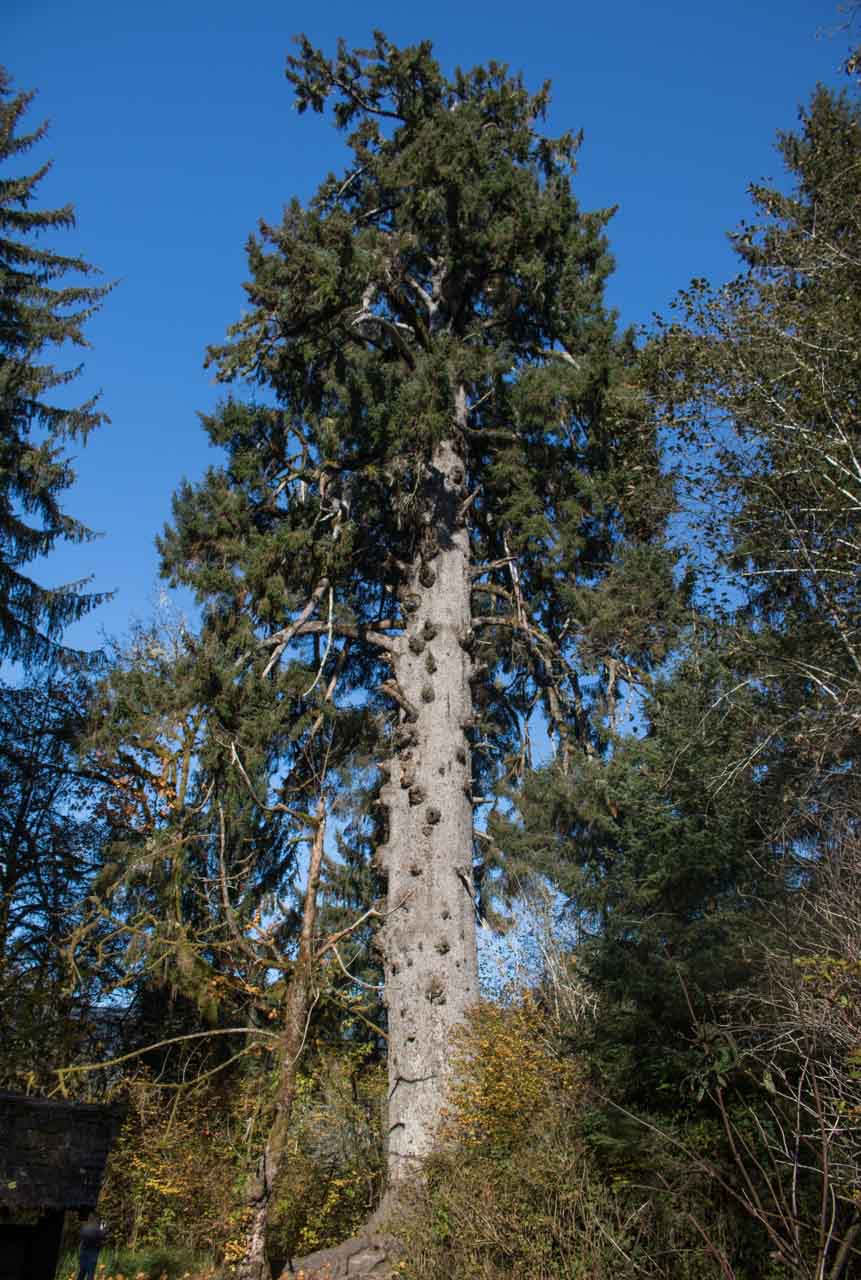
Nicknamed the Valley of the Rain Forest Giants, the Quinault Valley is home to no fewer than six of the world’s tallest trees. These so-called “champion trees” are recognized as the largest living individuals of their species.
There are, for example, the largest western red cedar, the largest mountain hemlock, and the largest Douglas fir in the world. While some of them aren’t accessible, there are a couple that are super-easy to see.
The most conveniently accessed tree is the world’s largest Sitka spruce tree.
Located only 1,200 feet from the Rain Forest Resort Village, this sylvan behemoth is more than 1,000 years old, 191 feet (58.2 meters) tall and 17.68 feet (5.4 meters) in diameter.
See Numerous Lake Quinault Waterfalls
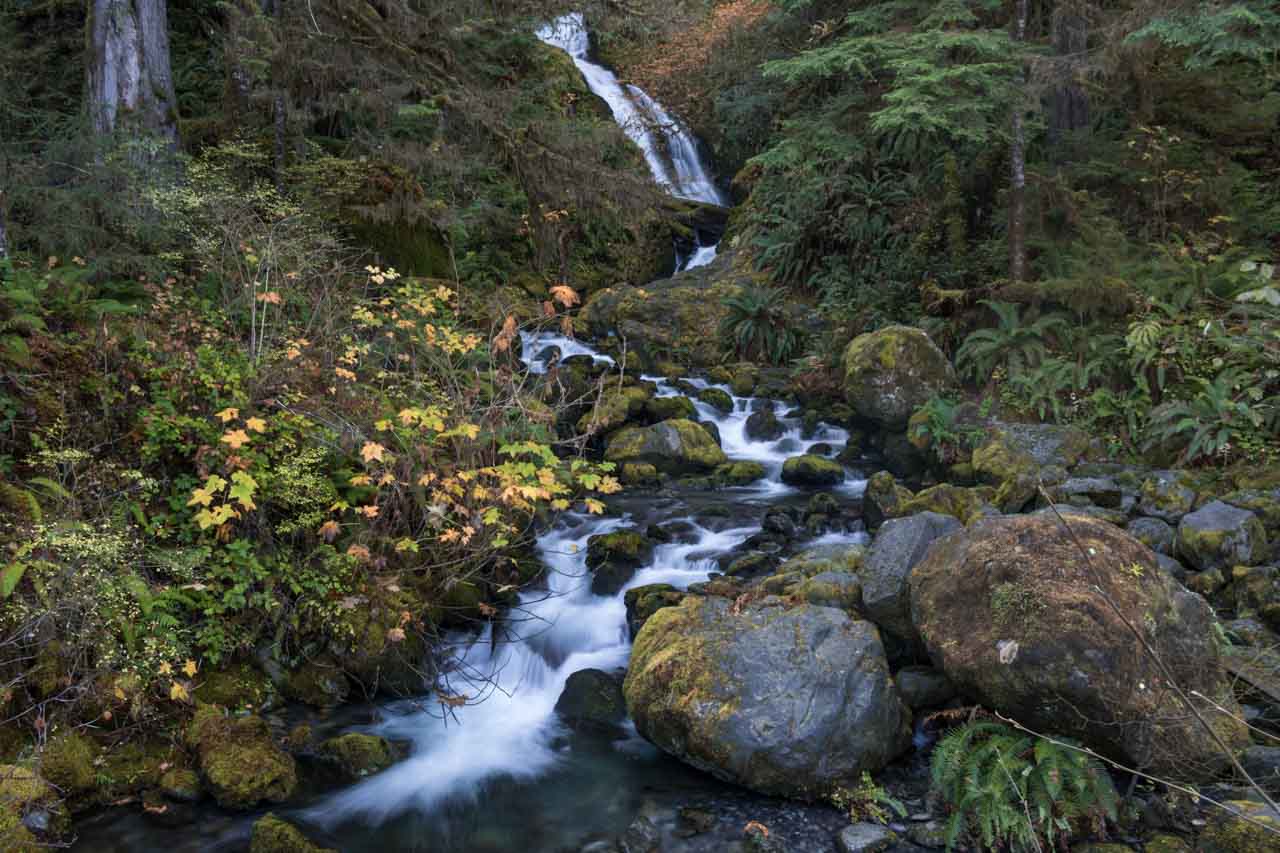
The Quinault Rain Forest is one of the world’s wettest places, receiving 12 feet (3.7 meters) of precipitation on average each year. So naturally, there are numerous cascades and waterfalls around Lake Quinault.
You can see a couple of them on the Quinault loop trails near the lodge, most notably Cascade Falls and Gatton Creek Falls.
The most beautiful Quinault waterfalls, however, are up the road. While driving the scenic loop drive, there’s Merriman Falls first, which I found a bit underwhelming.
Bunch Falls, on the other hand, is spectacular. Located just inside Olympic National Park on the south shore of the Quinault River, this 60-feet (18-meter) waterfalls tumbles down a mossy slope. It’s the tallest and most beautiful of the major lower Quinault Valley waterfalls.
Additionally, there are countless smaller, unnamed falls and cascades all over the Quinault Valley, too.
Hike the Cascading Terraces Nature Trail
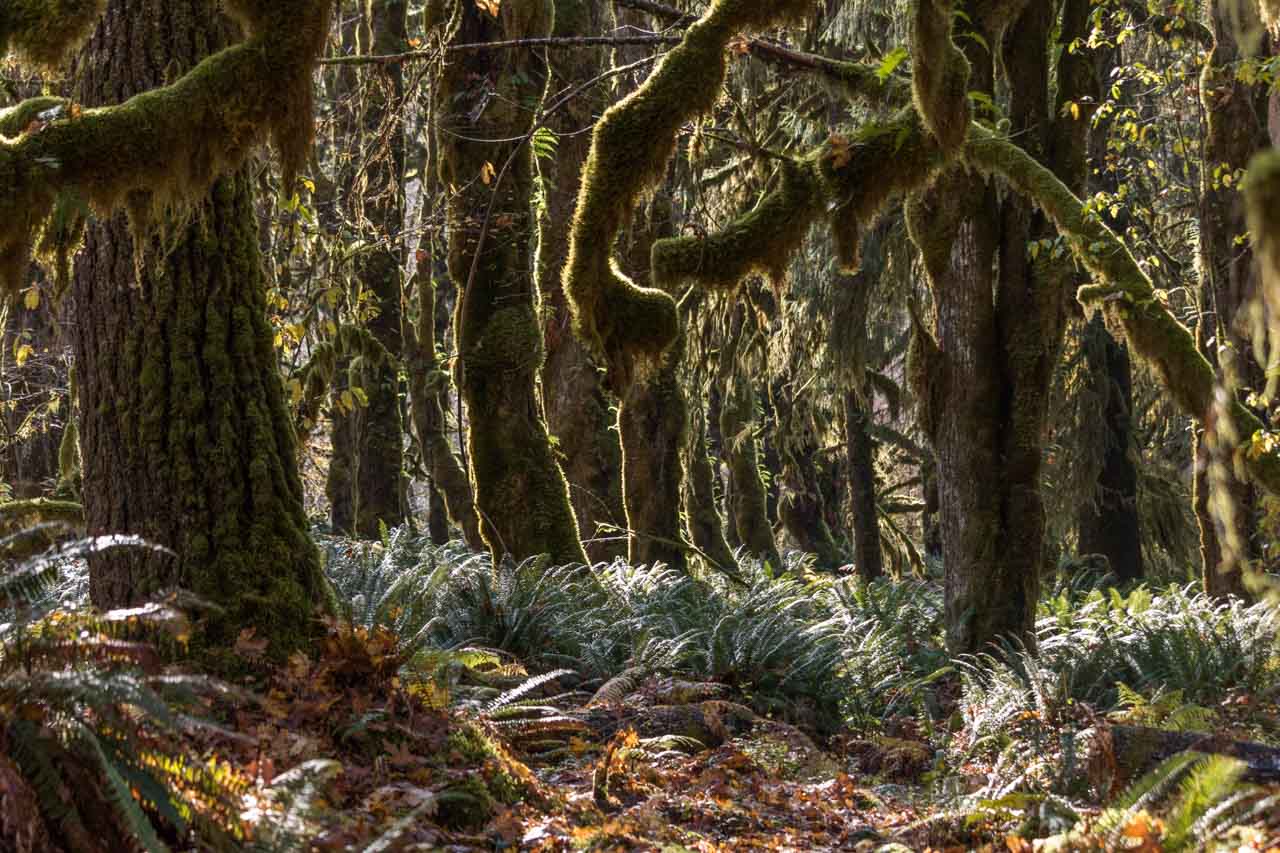
Graves Creek Road is a 6-mile extension of the Quinault Rain Forest Loop Drive. It continues along the south bank of the East Fork Quinault River to its terminus at Graves Creek Campground and the Enchanted Valley Trailhead.
During my visit in October, this was a rather rough road at places, with a few muddy and narrow sections. It was still easily passable with a 2WD car, though. However, as I said above, check road conditions beforehand, especially if the weather’s been in a bad mood lately.
At the Graves Creek Campground, the 1-mile Cascading Terraces Nature Trail winds its way to a super-lush rain forest.
Typical of these Pacific Northwest rain forests, there’s an abundance of moss, lots of fern coverage and some beautifully crooked trees. You can also get close to the Quinault River here.
I’d say this is one of the best short Quinault Rain Forest hikes, for sure.
Longer Cascading Terraces hike alternative: If you’re in the mood for a longer hike in the rain forest wilderness, nothing beats the roundtrip hike to Pony Bridge.
This 5-mile there-and-back hike starts at the Enchanted Valley Trailhead and leads to a gorgeously photogenic bridge across the East Fork Quinault River.
Enjoy Typical Pacific Northwest Scenery

This might be one of the more obvious things to do in the Quinault Rain Forest, but it’s definitely worth mentioning.
I put this after the Graves Creek Nature Trail because one of the greatest wilderness views on the entire loop is from the concrete Upper Quinault River Bridge.
Looking out at the Quinault River, flanked by pristine forests and glimpses of the towering Olympic Mountains, you can’t help but feel in awe. This is an unspoiled wilderness landscape, complete with (seasonal) salmon struggling against the swift current below you.
I urge you to pause here and take it all in. Walk across the bridge, look around, look up, look down, take a deep breath. This is a unique place and, if you give it a chance, it’ll show it to you.
Watch for Roosevelt Elk at Bunch Fields

Olympic National Park’s rain forest valleys are home to the largest population of unmanaged Roosevelt elk in the U.S. Today, the park protects about 3,000 to 4,000 elk, which incidentally are the park’s largest land mammal.
You may spot them all over the Quinault Valley, but arguably the best place for wildlife viewing in the Quinault Rain Forest is Bunch Fields.
This relatively open area is a preferred grazing ground for herds of elk. Additionally, black bears can occasionally also be seen foraging here.
Visit Kestner Homestead

An easy self-guided 1.3-mile loop trail runs from the Olympic National Park Quinault Rain Forest Ranger Station to Kestner Homestead.
This abandoned collection of farm buildings is a great place to learn about homesteading in the Quinault Valley.
Indulge in Fresh Salmon at the Rain Forest Resort Village Salmon House
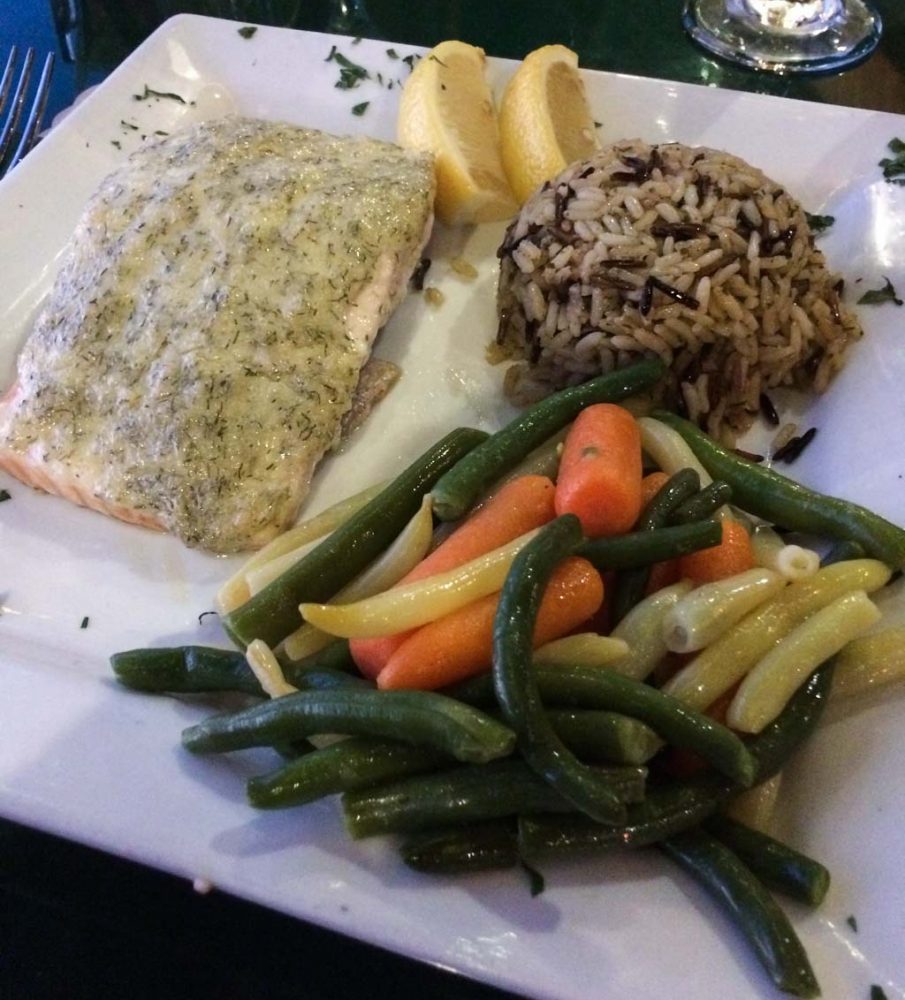
This is salmon country and a salmon dinner is basically mandatory after a day filled with Lake Quinault activities, hikes, sightseeing and wildlife watching. There are two dining options in the community of Quinault.
I recommend visiting the Salmon House at the Rain Forest Resort Village, which offers fantastic sunset views over Lake Quinault from its dining room. Its menu, unsurprisingly, is centered on salmon. Delicious!
Have Breakfast at the Lake Quinault Lodge Roosevelt Dining Room
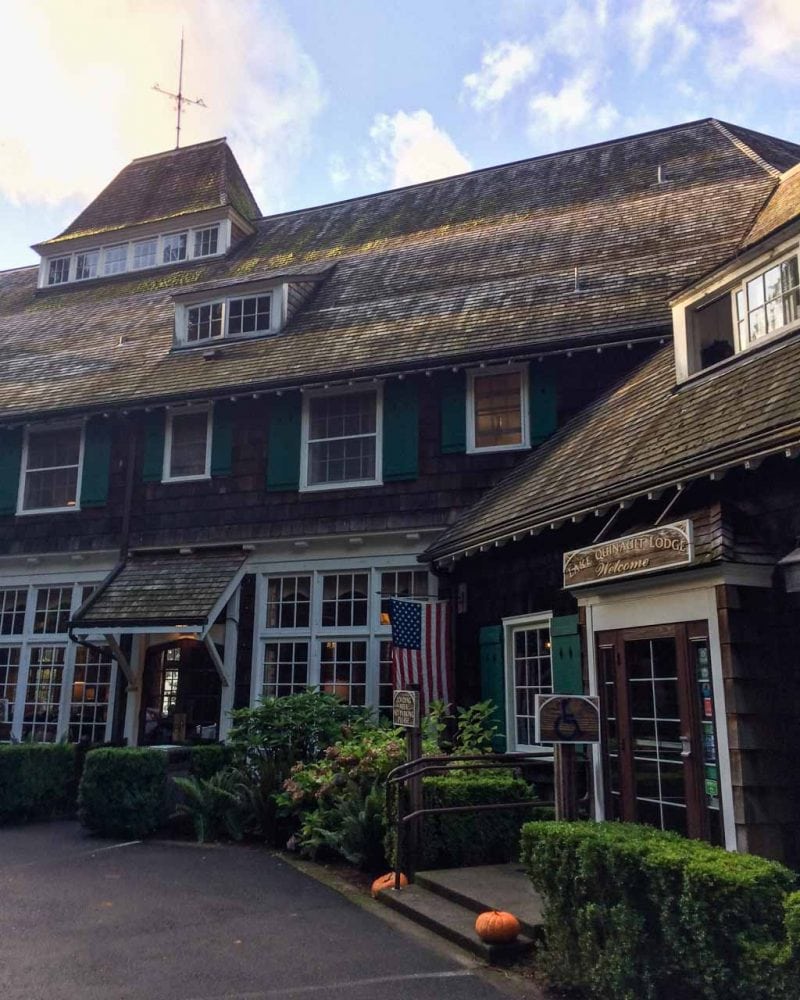
The Roosevelt Dining Room at the Lake Quinault Lodge, named after U.S. President Theodore Roosevelt who set aside the park for protection, is the only place in Quinault that serves breakfast. That lack of competition doesn’t mean subpar quality, though.
In fact, their breakfast menu is pretty impressive (although perhaps a bit expensive), with options ranging from granola, fruit and yogurt to biscuits with sausage gravy, and all kinds of eggs and pancakes.
I can’t imagine a better way to fuel up for a day of Quinault Rain Forest adventures.
Lake Quinault Accommodation
There’s no shortage of places to stay at Lake Quinault. From lodges, inns and resorts to a variety of campgrounds, whatever accommodation style you prefer, you’ll find it here.
Lake Quinault Lodging
The star accommodation at Lake Quinault is without a doubt the Lake Quinault Lodge. This beautiful historic lodge dominates the south shore.
It features a large sitting area, restaurant, grassy lawn with wonderful lake views, boat rentals and lake access. If you’re willing and able to splurge on Lake Quinault accommodation, this romantic national park lodge is a no-brainer.
A cheaper alternative, which I opted for, is the Rain Forest Resort Village. Accommodation options range from fireplace cabins to village inn rooms and suites. Many of them provide great views of Quinault Lake.
Additionally, the resort village is also home to the Salmon House Restaurant, has a general store and gift shop, and a laundromat and paid showers. This is the location of the world’s largest Sitka spruce tree, too.
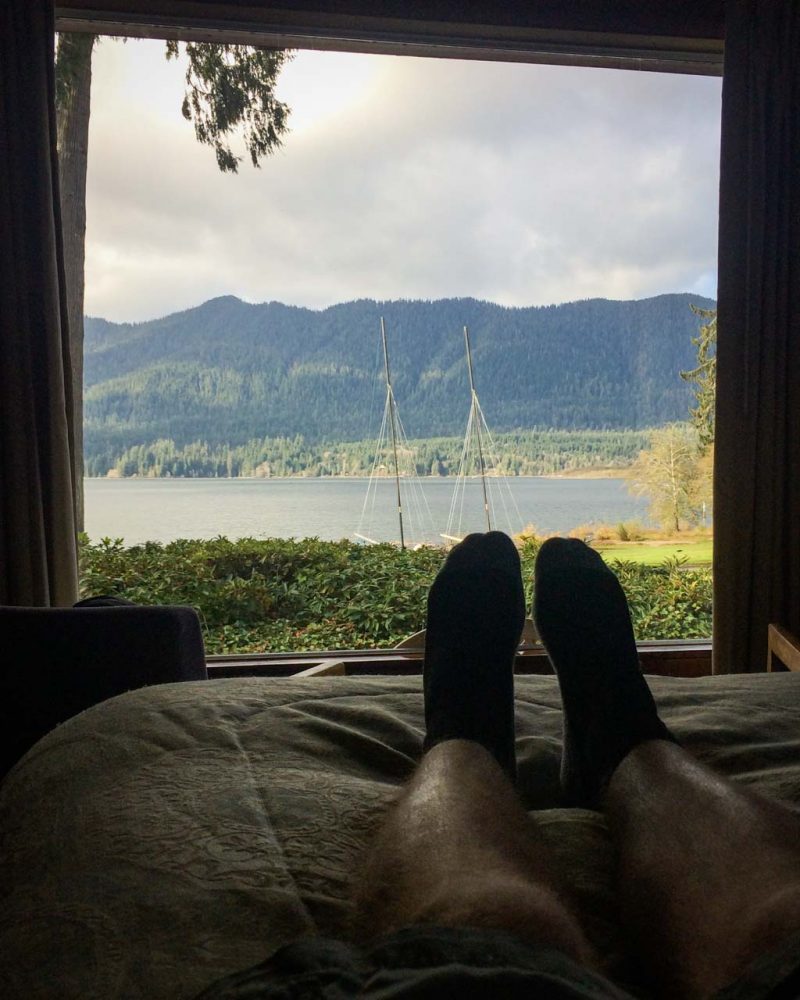
Lake Quinault Camping
Along the south shore of Lake Quinault alone, there are three different campgrounds—Willaby Campground, Falls Creek Campground and Gatton Creek Campground.
Offering amazing lake views, all of these are within Olympic National Forest. They’re a great option if you’d like to camp near at least some development.
For more remote camping in Olympic National Park, on the other hand, there are two options.
The North Fork Campground is a tiny campground with 9 sites and hardly any amenities, while the Graves Creek Campground has 30 sites, river access and a nature trail.
Lake Quinault Rain Forest FAQs

Where Is Lake Quinault?
Located on the Olympic Peninsula in northwestern Washington, Lake Quinault lies in the glacier-carved Quinault Valley in the southwestern corner of Olympic National Park. Fed by the glacial waters of the Quinault River, it’s surrounded by the pristine Quinault Rain Forest.
The lake lies just off of U.S. Route 101, which runs all the way along the Pacific coast, from northern Washington to southern California.
Approximate driving times to Lake Quinault from major towns and cities in the region are as follows:
- 1 hour from Forks, Washington
- 2 hours from Olympia, Washington
- 3 hours from Port Angeles, Washington
- 3 hours from Seattle, Washington
- 3 hours and 30 minutes from Portland, Oregon
From other main areas in Washington’s Olympic National Park, these are the times it’ll take you to get to Lake Quinault:
- 45 minutes from Kalaloch
- 1 hour 45 minutes from Hoh Rain Forest
- 1 hour 45 minutes from Rialto Beach
- 2 hours from Lake Crescent
- 2 hours and 30 minutes from Sol Duc Falls
- 3 hours and 30 minutes from Hurricane Ridge
How Long Is the Quinault Rain Forest Scenic Loop Drive?
The one feature that links together all the best things to do at Lake Quinault, the Quinault Rain Forest Loop Drive is 31 miles long.
It circles around Lake Quinault and a section of the upper Quinault River, leading into the unspoiled wilderness of Olympic National Park.
How Much Time Does the Quinault Rain Forest Scenic Drive Take?
The speed limit on the Lake Quinault Rain Forest Loop Drive varies between 25 and 35 mph. Often, however, it’s impossible to go that “fast” due to rough sections, steep inclines and sharp turns.
If you’d like to just drive the loop and not do any of the Quinault Rain Forest activities listed above, it’ll take you 1.5 to 2 hours to complete it.
On the other hand, if you’re planning on seeing the above-described Quinault attractions and doing some Lake Quinault hiking, you should count on at least one full day.
I recommend dedicating two days and one night to this area.

Is the Lake Quinault Loop Drive Suitable for 2-Wheel-Drive Cars?
On dry and sunny days, the loop drive is definitely suitable for 2WD vehicles. (I drove it twice with my front-wheel-drive VW Jetta.) A large portion of it is unpaved, but it’s graded and generally in decent condition.
As I mentioned earlier, though, make sure to check road conditions beforehand if you’re in doubt.
Additionally, the unpaved sections aren’t suitable for RVs or trailers!
What Is the Best Place to See Wildlife at Lake Quinault Washington?
Olympic National Park is one of the best U.S. national parks for wildlife viewing thanks to its unique combination of landscapes and ecosystems. And the Quinault Valley is a major one.
This lush river valley is home to an abundance of wildlife, including numerous birds, both resident and migratory, various mammals large and small, amphibians, fish and invertebrates.
On my two-day visit to the Quinault Valley, I saw banana slugs on the Quinault Loop Trail, a coyote at Kestner Homestead, salmon in the upper Quinault River, a loon and Canada geese on Lake Quinault itself, and elk at Bunch Fields.

So, you can see wildlife anywhere in the Quinault Valley. However, the very best place to see large animals is definitely the easternmost section of the Quinault Rain Forest Loop Drive in Olympic National Park.
Specifically, Bunch Fields is well-known for being a favored grazing area of Roosevelt elk and black bears alike.
Note: When hiking in areas where wildlife is present, it’s essential that you know what to do in case of an encounter. Please refer to the blog posts below for specific information:
- What to Do When Encountering a Black Bear While Hiking
- What to Do When Encountering a Cougar or Mountain Lion While Hiking
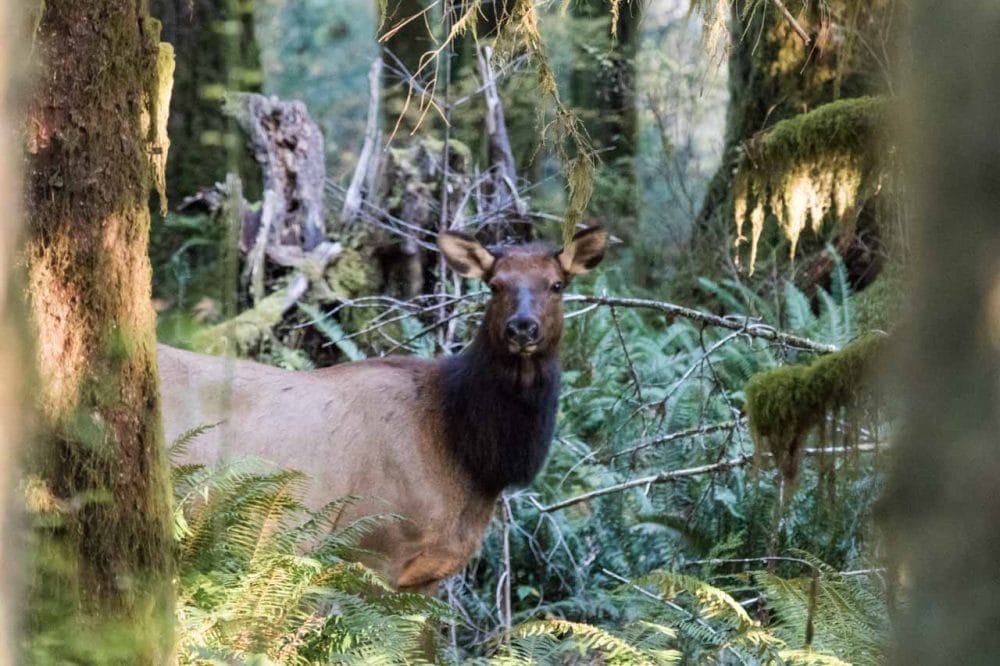
What Are the Best Hikes near Lake Quinault?
Hiking is definitely one of the top things to do at Lake Quinault. It allows you to really experience the rain forest, smell its scents, hear its sounds and see its wildlife.
The following are some of the best Lake Quinault trails. Just like the things to do at Lake Quinault above, they’re listed in a counterclockwise direction along Quinault Rain Forest Loop Drive.
- Quinault Loop Trail (1.5 to 8 miles, loop)
- Graves Creek Nature Trail (1 mile, loop)
- Pony Bridge (5 miles, out and back)
- Irely Lake (2.2 miles, out and back)
- Kestner Homestead Trail (1.3 miles, loop)
Is the Quinault Rain Forest Really a Rain Forest?
You bet it is! Although it’s located at a much more northerly latitude than the classic and well-known tropical rain forests, the Quinault Rain Forest is a temperate rain forest.
This type of rain forest exists only on the northwest coast of North America, in Chile, Southern Australia and New Zealand. The largest temperate rain forests on Earth, however, are those right here in the Pacific Northwest.
The Quinault Rain Forest receives an average of 12 feet (3.7 meters) of rainfall per year. This massive amount of water feeds waterfalls and lakes, creates phenomenal blankets of moss and ferns, and nourishes trees, which grow incredibly tall here.
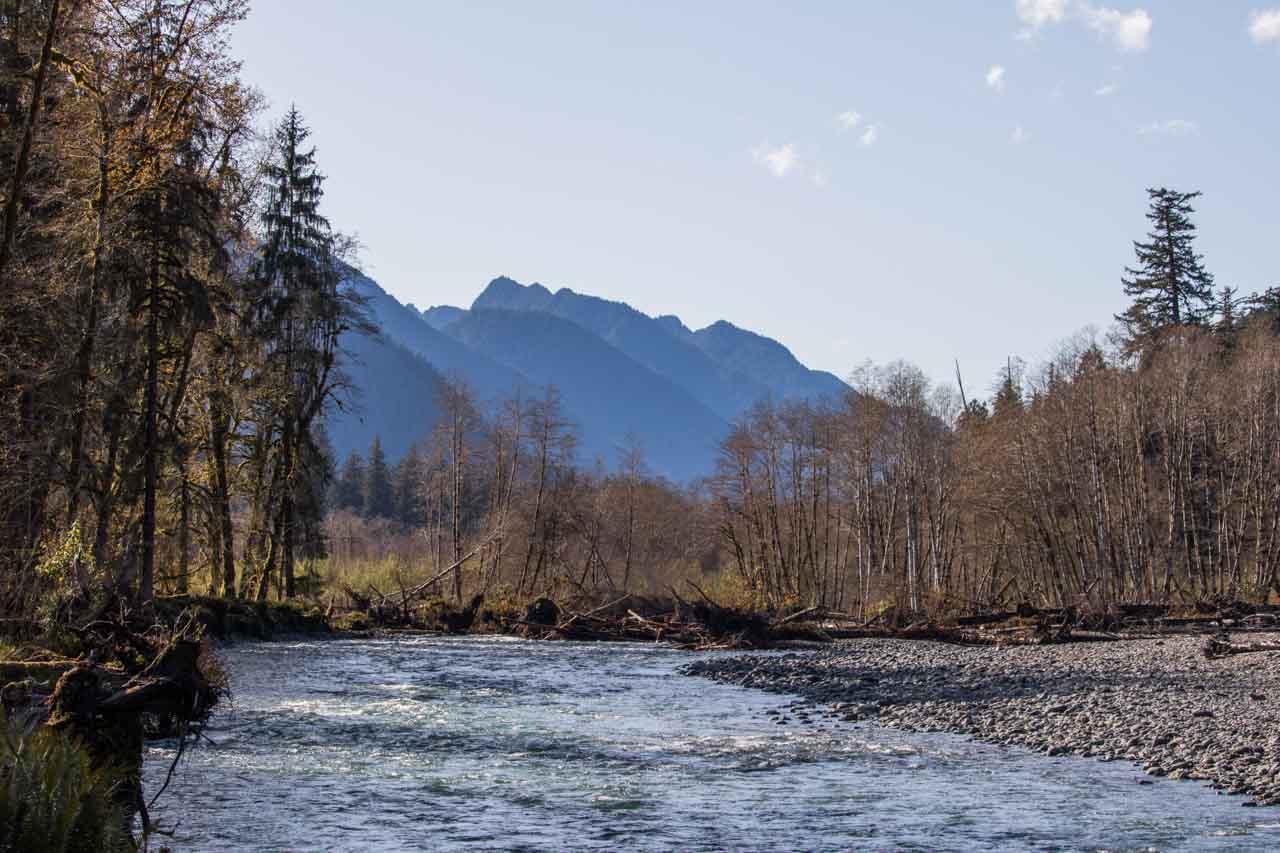
How Do You Pronounce Quinault?
As so many other place names in the Pacific Northwest, it’s difficult to know how to pronounce Quinault if you’ve never heard the word before.
This is how you pronounce Quinault: “kwin-ALT”.
More Quinault Valley Information
- Olympic National Park Quinault Area Brochure
- Olympic National Forest Quinault Page
- Community of Quinault Website

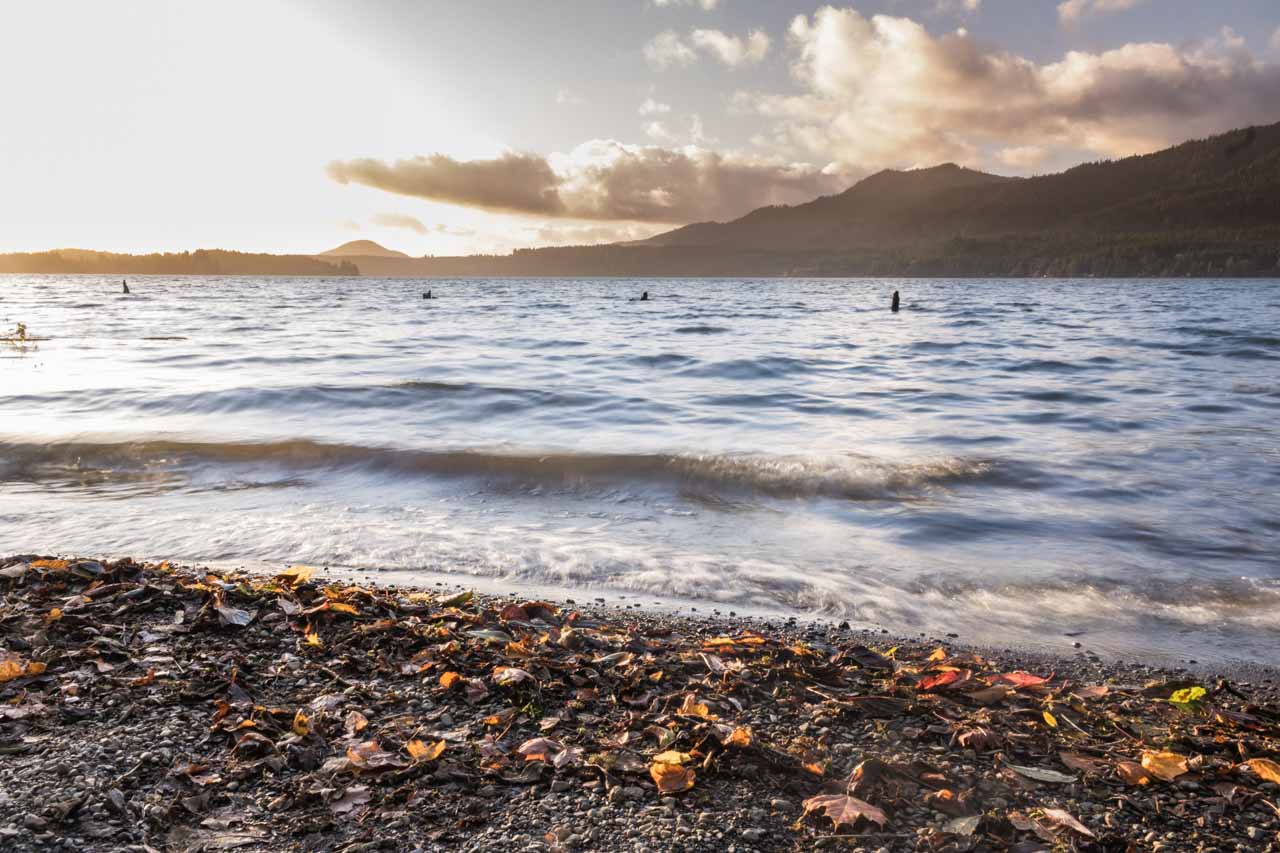
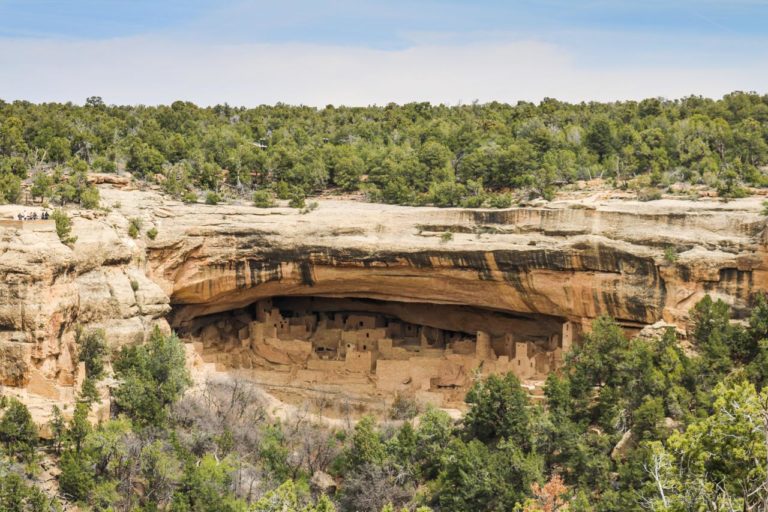




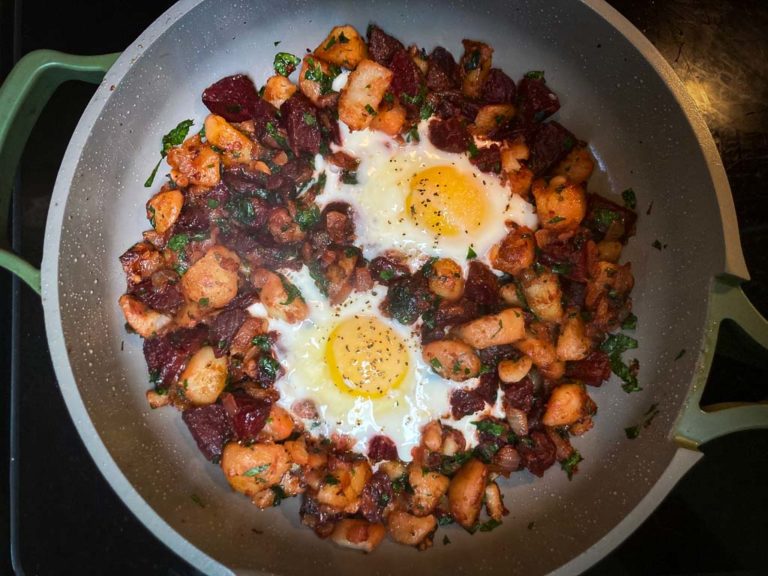
Can you recommend a rafting trip near Lake Quinault?
Hi Katherine! I haven’t done any rafting in that area myself, so I cannot recommend any business from personal experience.